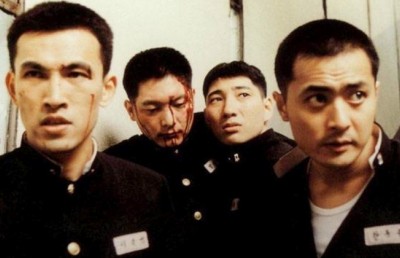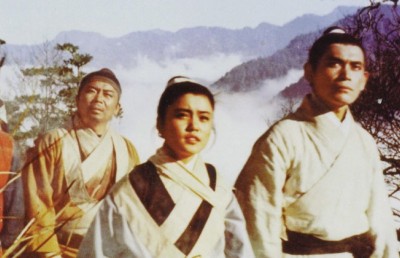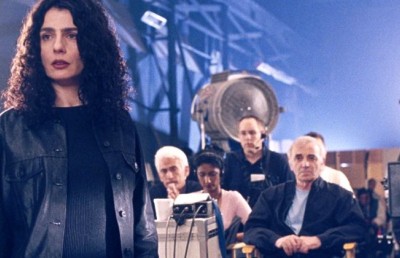The 26th Montreal World Film Festival
Jewels found outside the Official Competition

The 26th installment of the Montreal World Film Festival presents once again a plethora of films stretched across a host of sections (Latin American Cinema, Focus on Japanese Cinema, Panorama Canada, Films for Television, African Horizons, etc.). Having lost some of its clout in procuring the big name films means that the real jewels of the WFF will usually not be found in the Official Competition, but between the cracks (Cinema of Tomorrow: New Trends, World Cinema: Reflections of Our Time, and World Greats sections). Perhaps because of Majid Majidi’s unprecedented dominance in recent years, with three Top Prizes in recent years (Children of Heaven 1997, The Colors of Paradise 1999, Baran 2001), Iran has always been well represented at the WFF (luckily for the other filmmakers in competition, Majid Majidi was only a jury member this year!). So once again I chose to focus on the Iranian films, and once again was not disappointed.
The only Iranian film in competition this year was The Deserted Station (Istgah-e Matrouk) by Alireza Raisian. It is based on short story by Abbas Kiarostami, and it shows. The film strives to be like The Wind Will Carry Us, with the central character a photographer rather than a television reporter, but it lacks the master’s poeticism and reflective weight. It stars Leila Hatami from Leila (1997), again as a woman who can’t bear children. Although her character does not get the same awful treatment as in Leila, her ‘barrenness’ serves as the film’s central metaphor and driving force. The elegant Hatami, who added a touch of class and sheen to the evening by introducing the film in perfect French, could not raise the film above its rather maudlin (though well-meaning) intentions. The film never misses an opportunity to lay on the irony of the situation. The urbanite and barren Hatami is left to care for a group of village school children, tending to them like Mother Teresa and staring at them with wistful eyes. Among the villagers is a pregnant woman who always seems to be working. In another scene a sheep gives birth to a dead calf. And in the titular scene Hatami walks through the desolate compartments of a train at an abandoned station, with the sound of kids echoing on the soundtrack. In the end lessons are learned, with one particular girl overcoming her fear of trains, and Hatami accepting her biological fate. The final scene is interesting in the way it brings together three recurring conventions of New Iranian Cinema: cars, children, and sterile women. Hatami leaves the village by car, but the children, touched by her tenderness, don’t want her to leave and relentlessly run after the car.
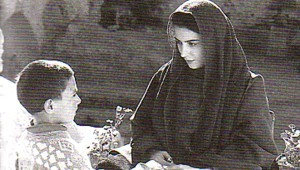
Leila Hatami
Another film along the lines of ‘lessons learned’ is the Japanese/Iran co-production road movie Farda (dir., Setsuo Nakayama, Japan/Iran, 2002). A 30-something Japanese businessman, Izava (Kai Shishido) is entrusted to deliver the dying wish of his fiancée’s father Murata, a man he deeply respected. Murata owned a small factory that produced industrial parts. Under duress of a failing business, Murata, in a moment of anger, fired a faithful, longstanding employee, an Iranian man named Mehdi. Unable to survive, Mehdi returned to his native Iran. Shortly after the closure of his shop Murata died of a heart attack. Murata’s diary reveals the deep regret he felt over his rash dismal of Mehdi, and the wish that someone search out Mehdi to apologize and pay him the salary still owed to him. Izava accepts and leaves for Iran in search of Mehdi. The film’s central dynamic is the culture shock faced by the slick, urbanite Izava as he tries to adjust to the slower pace of the Iranian countryside. Seen through Izava’s eyes, Iran is exoticized, but director Nakayama acknowledges this as part of the film’s text. This is comically rendered in the scene where Izava stops to take photos of a herd of camels, but it also informs the film’s concluding statement. In the film’s final shot, which echoes the film’s opening shot, we see a long shot of a truck driving along a picturesque road. It appears we are still in Iran. The image zooms out to reveal the image as a video billboard placed high above a large, busy Tokyo interchange (in a strange coincidence the image has a strong resemblance to a similar shot that ends Bill Viola’s Ancient of Days, 1981). The camera then tilts left to frame the busy intersection from above, where we see people scampering about like ants. This final image forms an ironic, stark contrast to the contemplative “Iranian time” and recalls the words recited by one of the minor Iranian characters Izava encountered on his journey: “rushing is the work of the devil.”
Marooned in Iraq by Bahman Ghobadi (Iran) is a very sad, tragic film about the Iraqi bombing of the miserable Kurdish along Iran-Iraqi border. Part-road movie, part serio-comic political drama, Marooned follows three musicians, an elder Mirza, and his two ragtag sons Audeh and Barat, as they travel through bombings and misery in search of Mirza’s ex-wife Hanareh in Iraq. Along the way the musicians do more fighting than playing, encountering warring clans, thieves, a pair of undressed policemen who claim to have been robbed, and a mass grave. At times Ghobadi’s high angle depiction of wintry, mountainous landscape recalls the epic scale of Tarkovsky’s Andrei Rublev (1967-71). Recalling another grand master, Renoir’s The Grand Illusion (1937), the film ends with Marzi making it to the barbed wire fence separating Iran and Iraqi.
Another impressive Iranian entry was the highly personal, political documentary Our Times (Ruz-egar-e ma, Rakhshan Bani-Etemad, 2002). Veteran director Bani-Etemad begins the film as a document of the 2001 Iran presidential elections, where 48 women placed themselves as nomination candidates (out of a total of 700 candidates put forth). In the first part of the film Bani-Etemad concentrates mainly on the groups of women in support of current President, the reformist Mohammad Khatami. In the second half Bani-Etemad sets her camera on one of the determined candidates, a single mother named Arezu Bayat. Bayat learns during the campaign that she has been evacuated from her apartment to make way for a higher paying tenant (and a more socially ‘honorable’ family). In the time honored narrative tradition of the deadline, Bayat has only three crucial days to find a new apartment and Bani-Etemad’s camera follows every step of her painful attempt to overcome the social stigma of being a single mother and find an apartment. The film is filled with dead ends and failure, climaxing with some heart-wrenching teary-eyed close-ups of the despairing Bayat. We learn that in the end, the Council of Guardians overruled the women as eligible candidates. An effect of the film is to problematize the representation of women in Iranian society in terms of how we in the West should understand their treatment in relation to a global consideration of Iranian society. For starters, one can only assume that this film will never show in Iran. So who is the intended audience for the film? Bayat’s plight is so soul-stirring that one must also at least ask: does the film sensationalize or exploit her situation (as a subject, Bani-Etemad struck gold with Bayat). And then there is the usual irony that perplexes Westeners: how can a society which is so harsh on this particular woman, and by extension other Iranian women, allow such a brave and critical film to be made by a woman? I guess these are paradoxes which can only exist in a society as complex as Iran’s?

Iranian President, Mohammad Khatami
Also impressive, although not exactly new territory for Dariush Mehrjui, is Bemani, a trilogy of tales based around three women living in a remote village near the Iraqi border. Some might see this as Mehrjui’s answer to The Circle (2000), but you must remember that Mehrjui has been portraying strong female characters long before Jafar Panahi. In the first two episodes the women succumb to the social guillotine of Iran’s patriarchal order. Quite literally in the first story, where a woman is decapitated at the bequest of her male family members for an innocent encounter with an Iranian soldier. The second story also ends in tragedy, when a young woman imprisoned in the cellar by her father for studying medicine without his knowledge, commits self-immolation. In the third story, a young woman is married off to a wealthy older man in exchange for the family not having to pay rent. The woman is reduced to a domestic slave. Tragedy also prevails in the third story, but the film’s title, meaning “to stay alive,” is reflected in the third character’s defiant spirit. Lacking the visual style of his earlier films, Bemani sets itself apart from other women-in-social-peril films with its stark and violent imagery. It is undoubtedly a brave film, but one wonders how many more films like this do we need?
Taraneh, Panzdah Sal Daram (I’m Taraneh, 15) by Rassul Sadr-Ameli demonstrates that the spirit of Italian neo-realism is alive and well in Iran. In fact the titular 15 year old girl could just as well be the young, pregnant maid from Umberto D (1951). Taraneh exhumes human perseverance as she survives against all odds to raise a baby alone, while the child’s equally young father is free to live unfettered by any responsibility, protected by family and social decorum. Taraneh begins as if it will be a stringent political tract in the vein of Panahi’s The Circle, but ends up taking a more universal route of humanism (as an coincidental alliteration with this film’s title, Samira Mahkmalbaf was born in Teheran on the 15th of February).
Coupled together on the same program were two short films Möte Med Ondskan (Meeting Evil), a Swedish production directed by Iranian Reza Parsa, and Mohsen Makhmalbaf’s Alefbaye Afghan (Afghan Alphabet). The Makhmalbaf short was a minor companion piece to Kandahar, with Afghan refugee children replacing women. Abrasive and chaotic, its main political point is the troubling reality of these refugee Afghan children having no recourse to an official education (also echoing the general subject of Samira Makhmalbaf’s Blackboard, 2000). Far more effective and disarming is Meeting Evil, a strangely haunting political poem. The majority of the film is a static camera setup of a terrorist seated in the back seat of a car addressing a video camera fixed in the front seat. Offscreen we hear the raucous sounds emanating from a nearby stadium. We learn that once the recording is over the man is planning to enter the stadium and set off the explosives wrapped around his body. The video tape is the terrorist’s suicide/love message to his daughter and wife, as he tries to explain his action and reaffirm his love. Should we loathe him or understand his plight? Director Parsa gives us no guidance. The minimal aesthetic works toward the film’s neutrality, leaving all moral judgment completely in our hands.
Leaving behind Iran, one of the most provocative films of this year’s festival was Varuh Meje (Guardian of the Frontier), the first Slovenian film directed by a woman, Maja Weiss. The film starts out as teen Deliverance (1972), but changes gear a third of the way in and becomes a psycho-sexual drama with possible political ramification (the rape of women during Bosnian war). Three nubile, attractive female teenagers start off on a boating excursion along the Kolpa river, which divides Slovenia from Croatia. Before too long creepy point of view shots from the shore are intercut into the objective narration, cueing us to an offscreen voyeur. As they venture further into the woods the three young women, the outgoing Alja (Tanja Potocnik), tomboyish Zana (Pia Zemljic), and conservative Simona (Iva Krajnc), begin to act out their true selves. Alja reveals herself as a man-hating lesbian, who lusts after Zana, while Simona, in contrast to her plaid image, has recurring rape fantasies featuring a lecherous right-wing politician (Jonas Znidarsic). The film stutters when interjecting the subplot of the reactionary Croatian politico who fancies himself the “guardian of the frontier.” More interesting than the surface politics are the film’s gender politics. For the first third of the narrative the three lithe, attractive teens are nude or in skimpy swimwear. The camera frames their exposed bodies as lovingly as the surrounding landscape. So much so that the viewer (or at least this one!) becomes conscious of the spectacle and begins to identify with the unseen voyeur in the woods. Although the film moves away from this visual setting, it did make me wonder: does the fact that the director is a woman have any affect on the question of male voyeuristic pleasure (or lesbian for that matter)?
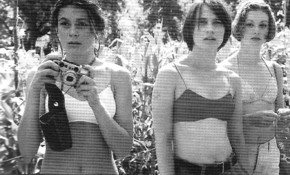
All about the ‘look’?
If there was a clear standout at this year’s fest it was Amos Gitäi’s Kedma. It would have a reasonable stake to that claim based on its amazing opening and closing shots alone. The opening shot in fact recalls Gitäi’s Kadosh’s (1999) in its structure: an extremely long take where the actions include a couple making love, followed by a man getting up to dress. Although the film takes some liberties with history, it is a powerful crisscrossing of two exiled peoples at the beginning of the state of Israel: the homeless and concentration camp survivor European Jewry arriving at the shores of Palestine, and the Arabs displaced by Jewish settlers. The time is May 7, 1948, one week before the formation of the State of Israel. A cargo freight named Kedma (“Toward the Orient”) arrives on the shores manned by outgoing British troupes and Jewish resistance fighters (Palmach). Gitäi places us directly into the fray of this transition with the earlier mentioned opening shot which takes us from the singular act of lovemaking to a deck full of displaced Jewish men and women anxiously awaiting their future. This complex camera choreography is continued throughout the film, which at 100 minutes and roughly 50 shots has a remarkably high average shot length of 2 minutes. The long take is a Gitäi trademark, but has special resonance here, as it underscores the sense of necessary solidarity between this varied Jewry, and the at times ironic co-habitation of the Arabs and Jews in the same frame/shot. The weary travelers break up into groups and make their way inland with the guidance of the Palmach. The journey is rife with tension, some of it delivered with a healthy dose of humor. Such as the following exchange between a Jew (Klibanov, played by Moni Moshonov) and an Arab (Rawda) who cross each other’s path:
Klibanov: Where are you going?
Rawda: We’re fleeing?
Klibanov: Who form?
Rawda: The Jews. And you.
Klibanov: I’m fleeing.
Rawda: Who from?
Klibanov: The British.
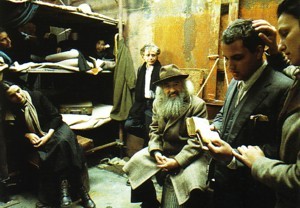
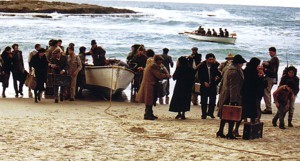
Kedma
Along the way, the Jews encounter a fortified Arab village and engage in an armed combat which kills several of the newly arrived Jews. Death, tragedy, displacement, and loss become too much for one member of the group, Janusz (Andrei Kashkar). In the film’s outstanding final 8 plus minute long take Janusz cracks under the pressure. With vehicles around him carrying the wounded and dead, and rain descending, Janusz begins to pace back and forth while reciting a long monologue on Jewish history which is clearly written from a contemporary perspective and will no doubt stir great controversy: “From the day we were chased from our country, we became a people without a history. The Messiah, a simple myth. Without him, everything would have been different. They would have finished by going back to Palestine or somewhere else, obligated to reflect on their future, only to end up with this nightmare. Israel is no longer a Jewish country. Not now, and even less than ever in the future. Everything is ruined, finished.”
A complete change of pace is the Italian film The Embalmer (L’imbalsamatore, Matteo Garrone, 2002), a quirky scope film featuring an odd relationship between a diminutive embalmer Peppino (Ernesto Mahieux, a dead ringer for Danny De Vito) and a young, good looking cook named Valerio (Valerio Foglia Manzillo). At first the attraction is one of profession: the young man is intrigued by the art of embalming and is taken under the master’s wing as an apprentice. But things turn decidedly sexual and kinky when the embalmer’s obvious physical attraction for the young Valerio begins to manifest itself. Along the way, Peppino’s consort with the mafia is revealed (he stashes drugs in corpses), a young, beautiful woman named Deborah (Elisabetta Rochetti) joins the fray, and the film turns into a taut, psychological road movie. The Embalmer presents a vision of Italy far removed from tourist pamphlets: dark, tenebrous, foggy, overcast, lonely, and dreary are the tones of the day. Director Garrone’s use of architecture and space, the lonely beaches, block-styled project tenements, and desolate border towns, coupled with a restless camera, recalls the great Michelangelo Antonioni. In the end love turns nasty and Valerio must choose between an unhealthy homosocial relationship with the volatile Peppino and a claustrophobic life of domesticity with Deborah (dead end job, living with her in-laws). The film ends on a note of ambiguity. Peppino confronts Valerio in a car park with the intention of stealing him from Deborah at gunpoint. A struggle ensues and a bullet is fired. It appears that Peppino is dead. Valerio sinks Peppino and his car in the river (a nod to Psycho, 1960). The scene changes. Valerio’s mother-in-law calls them down for breakfast. The scene cuts to the film’s final shot of a revisited space: the fog-ridden, tree-lined road along a riverbed. A diminutive man is seen walking in the distance away from the camera. Is Peppino still alive?
Continuing the long standing tradition of the road movie is The Warrior, a UK production helmed by Indian director Asif Kapadia. The film opens with a tranquil, slightly slowed down image, a long shot of an expansive desert landscape with a tree on the left side of the frame. A warrior enters the frame right. A Westerner? A Samurai? It is hard to tell, as The Warrior is an Indian answer to the Western and the samurai film rolled into one. The central character is Lafcadia (Irfan Khan), a Feudal court warrior, bodyguard, and tax collector who lives alone with his son. When a local village is lax on its payments the Lord sends Lafcadia to the town to “set an example.” In the middle of the murderous attack on the town Lafcadia has an odd vision: a single house nestled within the wintry Himalayan Mountains. A woman and young girl come out to greet him, his gaze riveted to the girl’s neck pendant. This singular moment out of time becomes a life changing experience for Lafcadia. Its exact status as a prophetic calling is made clear only at the end, making this a classic example of what theorist Noel Burch calls the ‘retroactive’ match edit (a cut whose meaning is only made apparent at a much later moment in the narrative). Lafcadia abandons his sword and court duties, but his Lord sets a warrior after his head, the price to pay for leaving his services. Lafcadia witnesses the slaughter of his son after he identifies another man’s head as his father’s. From this point on the film becomes a road movie, with Lafcadia the redemptive gunslinger traveling in search of the ‘holy lake.’ Along the way he befriends a young boy (a surrogate son) and a blind old lady who claims “I see the blood written on your face.” While on his journey some of the scenery, situations, and locations recall Chen Kaige’s Life on a String (1991). Lafcadia’s journey comes to an end with the revelation of his vision. Summer cuts to winter. The same woman and girl come out to greet Lacfadia out of their mountain house. The woman approaches Lafcadia and tells him, “She [her daughter] said you would come.” The powerful ending bundles together the classic iconic trajectory of the Western, Noir, and Samurai film of the gunfighter/outlaw who retires to a natural setting. Only here the act is not driven by individual desire but a prophetic calling by a young girl. The final shot recalls the famous ‘cyclical return’ ending of Ugetsu 1954): a high angle long shot of Lafcadia herding sheep on the side of a mountain. The camera pans left and tilts skyward to frame the snow capped mountains and sky.
Another road movie of a different ilk is the ‘feel good’ indie movie Britney Baby-One More Time (dir., Ludi Boeken). With warts and all, the film ultimately won me over with its infectious lead performance by Angel (Robert Stephens), basically playing himself as a gay cross dresser who wins a Britney Spears look-a-like contest (we should all be so lucky!). Joining the crew are Milwaukee’s American Movie ‘dudes’ Mark Borchardt (playing Dude Schmidt) and Mike Schank. Borchardt and Schank are two indie filmmakers slated to interview Britney Spears for a television entertainment show. Not too surprisingly, they are refused back stage access to Britney, but luck strikes twice when they happen across Angel at a local restaurant. Dude promises Angel he will meet Britney in New Orleans if he helps them in their ruse. Film crew in tow, the three join forces in a drive to New Orleans, filming off the cuff ‘live television’ Britney encounters with ‘common folk,’ fooling both the people and the television station into thinking they are interacting with the real Britney Spears. Highlights include Shanks’ offhand personal feelings about gay people, and the hilarious scene in a truck stop diner where a potentially violent encounter with a group of blue-collar truckers turns into a Britney Spears dance along! Luckily the film does not force feed its message of self-discovery and acceptance of gay sensibility in a non-gay world. This is one to see with a group of friends.
A part road movie, the amusing short La Chanson-Chanson (Xavier Diskeuve, Belgium) features an aspiring singer from Belgium, Walter, who gets accepted on a local Paris based talent scout show, which nobody but Walter seems to know about. The young grocery can barely contain his excitement, and keeps reminding doubters that Jacques Brel was Belgium! His only problem, how to get to Paris? Things look up when he manages to convince his taciturn, dim wit cousin to drive him in his farm car. In one the film’s funniest moment, the car gets stopped by flicks, who are alarmed by the car’s strong stench of fowl and easily impressed by Walter’s impending brush with fame. Walter and his cousin eventually make it to the hotel room. Prior to their departure to the television studio Walter, who we learn is asthmatic, collapses in the shower stall, gasping for his inhaler. Will the show go on? The scene cuts to Walter’s family back home settling in front of the television to watch their son’s moment of glory. The shot cuts to the television screen: rather than Walter, we see his country bumpkin cousin, in large close-up, crooning a la Brel! Though minor, the film plays the small-town humor card to a nice effect.
Another comedy with some entertainment value (if you are a baseball fan anyway) is Mr. Rookie (Satoshi Isaka, Japan, 2002). Ohara Koji’s (Nagashima Kazushige) stars as a 32 year-old salaryman who gets a second chance in life after a promising career as a high-school pitcher was curtailed by a shoulder injury. A physiotherapist with a secret medicine rejuvinates Koji’s arm. As fate would have it, the therapist also works for the hard luck Hanshin Tigers, and arranges a private tryout with the manager, Segawa (Hashizume Isao). Segawa is impressed with Koji’s blazing fastball and offers him a contract. Koji is ecstatic, but is worried that if things don’t go well this could compromise his comfortable job and jeopardize his family’s security. The manager comes up with a plan: enlist Koji to pitch only in the team’s home games at Koshien Stadium and have him wear a mask (recalling the wrestler in popular Korean hit The Foul King, 2000). Things proceed as you would expect in a sports movie, with Koji somehow managing to juggle a full-time job, family responsibility, and moonlighting as a professional baseball player! There’s a nice in-joke when the manager brings in surprise pinch hitter Randy Bass, a former major leaguer who became a huge star in Japan in the 1980’s, to hit a key pennant clinching home run. Mr. Rookie is a silly ‘salaryman-dream-fantasy’ in the tradition of The Rookie meets The Karate Kid, but one redeeming factor is that the baseball footage is better than most American films (capturing the rhythm of the game better).
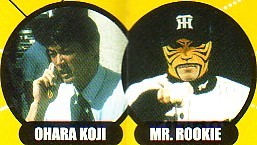
One of the more pedestrian films screened this years was Une Employée modèle (A Model Employee, Jacques Otmezguine, France, 2002), a thriller that held my interest until the final 20 or so minutes, when it became apparent where the plot was heading. It presents yet another French middle-age male fantasy. François (François Berléand) is a married, independent, self-made software millionaire who battles against the current of American (he calls them yanks) multinational corporate takeovers. Against the recommendations of his younger employees, François resists the American buyout, but not the charms of a beautiful woman who he meets in classic noir fashion. Driving home late one night a mysterious beauty appears on the road in front of his car. Florence (Delphine Rollin), supported by a black eye, tells François that she is running from an abusive husband and needs a place to sleep for the night. With his marriage on the rocks, François lets his guard down and falls for the much younger femme fatale in hiding. (I guess he hasn’t watched too many film noir, or else how could he have fallen for her trap?) So as to devote himself to his new love, François decides to sell his company to the Americans and retire with his millions. The plot thickens, however, when Florence’s imposter husband tries to blackmail them, and he later narrowly escapes an assassination attempt set-up by Florence (he is saved by Marxist cop!). He now realizes his folly, Florence was a lackey for the multinationals to get him to sell out, and plots his revenge. He returns to his factory at night, steals the hard drives and all the codes to his sought after “X27” software, blows the place up, and drives off to rebuild his empire. In the film’s ambiguous beachside coda, we see Florence ‘bumping’ into François’ wife and daughter, asking them if their beach house is for sale. Although the film sports fine performances, it foregoes any noir stylistics for a more realist-based world. However, once the plot becomes evident, there is not much else to hold our interest.
For some reason the WFF has always shied away from horror and science-fiction (to my regret). This year is no different, with only two films falling into this category, The Nature of Nicholas (Jeffrey Erbach, Canada, 2002) and May (Lucky Mckee, 2002). Erbach’s film, which straddles horror-as-metaphor and coming-of-age, was one of the more intriguing films of the festival. Though the 20-something Erbach hails from Winnipeg, this is not as comical, stylized, or surreal as the work of Guy Maddin or John Paisz, but a near Bressonian quietude in its use of heightened natural sounds, minimal music, and under-played dramatics. Where Erbach perhaps does borrow from Maddin/Paisz is in the ambiguously coded time frame. The slicked back hair styles, cardigans, surfer music, pastel colors, and spin-the-bottle parties definitely recalls the fifties, but we can never be certain. When not at school, the prairie-living twelve year old Nicholas (Jeff Sutton) spends his days dissecting bugs in his barn workshop. His father dead, Nicholas’s social contact comes in the form of his mother (Ardith Boxall) and best friend Bobby (David Turnball). Unlike Bobby, Jeffrey seems indifferent to the opposite sex and prefers solitary time with Bobby over girls and house parties. In an unguarded moment, Nicholas plants a harmless kiss on Bobby’s lips. The taboo kiss causes Bobby to sprout a nasty-looking doppelganger: a decaying zombie version of Bobby. Desire, in this case homosexual, seems to have directly led to Bobby’s splintered psyche/identity (we also still see an apparently healthy, although emotionally confused, Bobby). The narrative gesture, along with the return of the dead father, is reminiscent of Bob Clark’s minor masterwork Deathdream (1972), where a Mother’s well-meaning wish brings her dead Vietnam soldier son back to life. At first the taboo kiss does not affect Nicholas, who remains within his single identity and begins to care for the sickly Bobby, like a responsible Dr. Frankenstein. However, Nicholas has a second zombie to deal with, his dead father. Like Maddin, we sense a Freudian presence of the ‘dead father’ who returns to admonish fatherly guidance. The father’s presence occasionally ups the horror quotient. On his second visit the father appears at the kitchen door, his zombie makeup more pronounced, scratching pathetically at the screen. As the narrative develops the father’s role becomes more important, eventually replacing the mother, in quite the literal sense when he twists a knife into her back while mimicking her voice. Nicholas also begins to slowly transform into a zombie, as part of a ritual which sees him reborn at the end. His father takes him into a house where another boy zombie (Bobby? Nicholas?) is huddled in a corner covered in webs. The father consoles Nicholas, “It’s all in the past.” One wonders, what is “all in the past”? His homosexuality? His loneliness? In the final scene a healthy looking Nicholas is walking toward a new school, with his muse father behind.
Another popular genre film that is usually not represented at the WFF is the action or gangster film. Although not conventional in any sense, the Brazilian Cidade de deus (City of God) breaks this pattern. If marketed properly (i.e. for the young ‘hip’ sect), this gangster film by Fernando Meirelles (and co-director Katia Lund) has the potential to be a huge hit. City of God does for the ‘rise and fall’ gangster film what the Brazilian nation does for football (soccer): add flair and style, oodles of it. Think Lock, Stock and Two Smoking Barrels (comic twists), NBK (rapid-fire montages), Pulp Fiction (zigzag narrative temporality), and Goodfellas (personalized voice-over narration, epic scope). Echoing the environmental determinism explored as far back as the early 1930’a (Public Enemy, Angels with Dirty Faces), City of God parallels the life of two childhood pals growing up in the 1960’s slums of Rio de Janiero (favelas), one taking the route of crime, the other becoming a famous newspaper photographer (the film spans into the 1980’s). Echoing the gritty casting strategy of Timeless, Bottomless Bad Movie (Sun-Woo Jang, 1997), Meirelles and Lund selected 110 nonprofessionals from varying Rio de Janeiro slums to work with over an eight month workshop and improvised much of the story from their real life experiences. Although heavily based on reality (a docu-novel by Paolo Lins), the film is ostensibly a kinetic entertainment ride with little attempt at getting behind the social problems behind the crime (outside of a few corrupt cops and an uneasy relationship between the media and social agency). Although at 135 minutes the hyper energetic style does become exasperating, there is much to praise in this sexy, violent epic of love, revenge, crime, and survival.
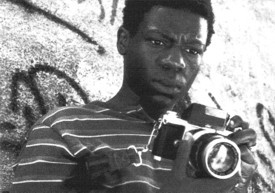
Rocket, our narrator and the soul survivor
I’ll conclude with the return of the conquering hero, Chinese director Huo Jianqi, who won the Prix du Public (Audience Award) here in 1999 with his touching rural-based coming of age Postman in the Mountains. Jianqi returns with something decidedly different, yet equally impressive: Life Show. Jianqi sets his camera in an urban setting, concentrating on one particular night market on Ji Qing street that specialises in duck neck and is owned and operated by one feisty woman, Lai Shuang Yang (Tao Hong). Life Show joins other films in this year’s roster that feature ‘survivors’ (Taraneh, The Little Monk, and The Warrior). Only in this case, Yang’s character battles against social strife from all sides: a sick brother in a sanitarium, a depressed employee, a nosey sister-in-law, a struggle to reclaim an old family property claim, and the persistent advances of a silent admirer, Zhou Xiong Zhuo (Tao Zeru), who ends up being a land developer attempting to ruin her livelihood. Although different from Postman in many ways, centrally because of its urban setting, Life Show is similar to Postman in one respect: the expression of strong emotions through visual means. In Life Show this comes out in the loving representation of the night market stall where Lai works. Director Jianqi makes everything about this city straddling the Yangtze river (Wu Yen?) luminous and beautiful: the large modern plazas, the high wire commuter trains, and the narrow city lanes. Life Show ends with a freeze frame on Lai’s tired yet beautiful face. Lai is not a nice character by any means, exploiting people around her to survive, but through the force and energy of her largely silent performance, we can not condemn her either.




